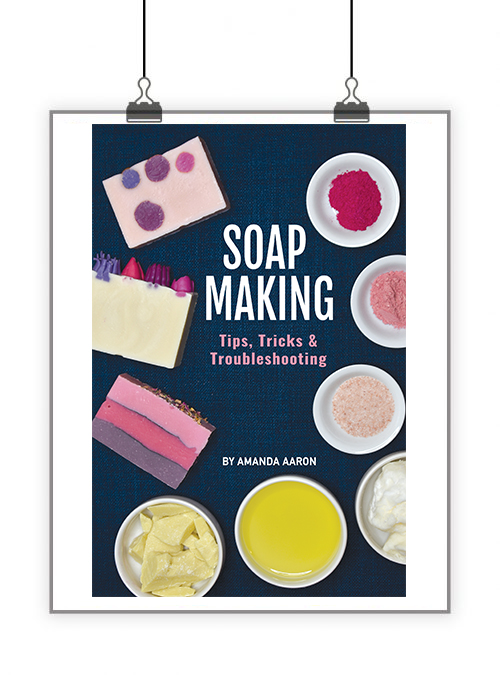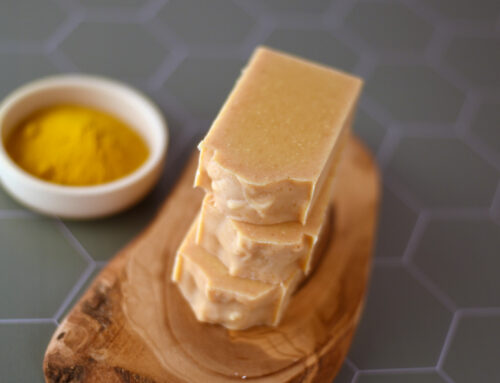Soda ash (commonly referred to as ash) is a pesky little problem that just about every soap maker has encountered at one time or another. You put your soap to bed…wake up in the morning and there is a white powdery layer of “something” blanketing the surface of your soap.

What is that “something?” It is sodium carbonate. Sodium carbonate forms where active lye meets air. We know it is sodium carbonate if it is soluble in water (you can rinse it off) and it completely covers the surface of the soap that is exposed to air.
How do we prevent it?
Cover your soap in the mold with wax paper or plastic wrap to keep the air from “touching” the surface as it saponifies.
If you’ve created peaks, a designed surface or a swirl, then you can spritz with alcohol. I usually pour my soap, wait about 10 minutes for it to set up a bit, spritz with alcohol, spritz again after an hour.
You’ll want to use the highest grade of rubbing/isopropyl alcohol that you can find. Alcohol works by dissolving the ash as it forms, creating a barrier between the soap and air.
If we get it, how do we remove it?
Since ash is just an aesthetic issue, you can remove it from the bar of soap to “fix” the problem. You can do this by rinsing it off with water either by putting it under running water or by rubbing it off with a damp cloth. Follow the rinse with a spraying of alcohol to help the water evaporate more quickly.
If your soap bars have flat surfaces, you can use a vegetable peeler or soap planer to remove the ashy surface.
I’ve heard of some people using a steamer to steam the ash off. I haven’t personally tried that but I know it works!
Nowadays, I simply embrace it. If I forget to spritz a soap with alcohol to prevent it, I just go with it. Sometimes ash can even enhance the look of a soap!
I asked in our Facebook Group what other soapers thought about ash. Here are some responses.
Jennifer Monsini @ The Hippie Farmer said, “I actually love it!! Some soaps… like my Black and Tan Beer soap looks stouty with the ash on top. I’ve learned to embrace it when it happens.”
Jerika C Zimmerman @ Quench Soap said, “I personally don’t like it. I used to get it a lot and the only thing that worked was a water discount.”
Sonja Read said, “I use 1% beeswax and never get ash.”
Kathy Scott Heiner said, “I prefer not to get ash. I soap at room temp using a water discount, then CPOP. If I do get ash, I spray with rubbing alcohol. If that doesnt get it, then I spray with distilled water, followed by RA, or wash with water, then spray with RA.”
Lisa M. Price said, “I use alcohol immediately after pour, also use steam after cure if needed. I soap at about 28-30% water most times, so I don’t have much of an issue normally.”
What do you think about ash? Does it bug you or do you just leave it?

Want more tips and tricks? Check out my eBook, Soapmaking Tips, Tricks & Troubleshooting!

In Soapmaking Tips, Tricks and Troubleshooting, I provide extensive troubleshooting advice for when soap goes wrong. Moving beyond the basics, this book discusses advanced topics such as superfatting, water discounts, fatty acid profiles, gel phase and more.
Focusing on tips and tricks that make soapmaking more efficient, Soapmaking Tips, Tricks and Troubleshooting addresses advanced ideas, terms and definitions, helping you go from soapmaking novice to master.
With input from over 100 soapmakers, you’ll learn advanced techniques that improve your craft and make soapmaking infinitely more fun.











i hope you can help with this query
i have always used IPA for the last 8 years soaping because i would get soda ash no matter what i did to protect my soaps
they are precious to me – lol
now with a change of supplier for the IPA the problem i am getting when i use it – is wrinkling on the flat surface
the supplier is trying to say that it is because it is cold process soap and not melt and pour and to only use IPA on melt and pour
i dont get it
i dont understand it
i have never had the wrinkly problem – ever – never
is my supplier right??
liz